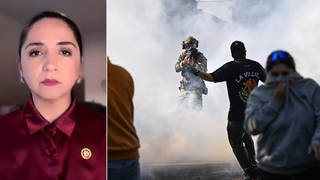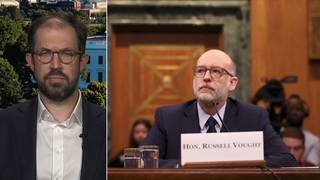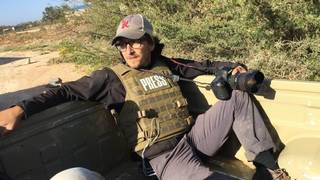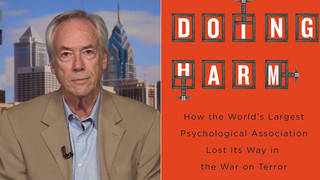
Guests
- Nathaniel Raymondresearch ethics adviser for Physicians for Human Rights. He is also a researcher at the Harvard School of Public Health.
Physicians for Human Rights is calling for a federal commission to investigate, document and hold accountable all health professionals who took part in CIA torture. Last week, the group released a report titled “Doing Harm: Health Professionals’ Central Role in the CIA Torture Program.” The report finds medical personnel connected to the torture program may have committed war crimes by conducting human experimentation on prisoners in violation of the Nuremberg Code that grew out of the trial of Nazi officials and doctors after World War II. We speak with Nathaniel Raymond, a research ethics adviser for Physicians for Human Rights, who co-wrote the new report. “We now see clear evidence of the essential, integral role that health professionals played as the legal heat shield for the Bush administration — their get-out-of-jail-free card,” Raymond says.
“There has often been this narrative that Mitchell and Jessen were the lone gunmen of torture, that they were doing this out of their garage,” Raymond explains. “They were operating inside a superstructure of medicalized torture. It was not just them alone. It includes physicians’ assistants, doctors and it may include other professionals. What they were doing was everything from 'care' to actual monitoring, calibration and design of the tactics.”
Transcript
AARON MATÉ: Calls are increasing for the prosecution of Bush administration officials tied to the CIA torture program. On Monday, the American Civil Liberties Union and Human Rights Watch called on Attorney General Eric Holder to appoint a special prosecutor to probe the crimes detailed in the Senate Intelligence Committee’s report. Also on Monday, The New York Times editorial board called for a full and independent criminal investigation. Meanwhile, the group Physicians for Human Rights is calling for a federal commission to investigate, document and hold accountable all health professionals who took part in CIA torture.
AMY GOODMAN: Last week, the Physicians for Human Rights released a report titled “Doing Harm: Health Professionals’ Central Role in the CIA Torture Program.” The report finds medical personnel connected to the torture program may have committed war crimes by conducting human experimentation on prisoners in violation of the Nuremberg Code that grew out of the trial of Nazi officials and doctors after World War II.
Joining us now is Nathaniel Raymond. He’s a research ethics adviser for Physicians for Human Rights. He co-wrote the new report. He’s also a researcher at the Harvard School of Public Health.
It’s nice to have you back, Nathaniel. So, start off by talking about the human experimentation. What came out of the CIA documents?
NATHANIEL RAYMOND: Well, I would say that there were two incidents in the Senate Select Committee on Intelligence executive summary that have been largely overlooked by the press. One is the Office of Medical Services raising concerns to the inspector general in 2005 at CIA that they were being asked to potentially commit human experimentation through the required monitoring role to study the efficacy and the quote-unquote “safety” of the tactics. Additionally, the report shows two senior former CIA agents were asked to do an independent review of the CIA interrogation program and declined to assess the efficacy because they said it would, quote, “violate federal policy” on human subjects research.
What we see clearly in this report is that the Office of Medical Services’ role evolved from the time of the Yoo-Bybee memo in 2002 and 2003 into something very different by the Bradbury memo in 2005. They were actively engaged in collecting data, in assessing the potential impact, the harm, of these tactics. That role can constitute research and can constitute a violation of international war crimes prohibitions on human subjects experimentation, because what they were doing was unrelated to the medical care of detainees, and it had no clinical precedent, and it involved the analysis of identifiable data from detainees who were being tortured.
AARON MATÉ: So what does this evolution indicate to you?
NATHANIEL RAYMOND: It indicates this: that the U.S. government swallowed the spider to catch the fly of torture. And they swallowed the spider of weaponizing health professionals to engage in a role that has been widely documented and prohibited by the Nuremberg Code and also by U.S. domestic war crimes law as constituting potentially a crime against humanity. Now, I want to be clear here: There’s no hierarchy of harm between torture and alleged human subject experimentation. Both are illegal, and both can constitute war crimes. But the fact here is that we now see clear evidence of the essential, integral role that health professionals played as the legal heat shield for the Bush administration—their get-out-of-jail-free card.
AMY GOODMAN: So, let’s talk about the different professions.
NATHANIEL RAYMOND: Yes.
AMY GOODMAN: We’ve talked to you a lot over the years about psychologists, and we’ve done several big segments in the last few weeks. We know about the psychologists Bruce Jessen and James Mitchell—
NATHANIEL RAYMOND: Yes.
AMY GOODMAN: —and their role in the torture. But talk beyond these two men, as the attempt is made for them to be isolated, the role of the American Psychological Association, the largest association of psychologists in the world, but then beyond that—psychiatrists, doctors, nurses.
NATHANIEL RAYMOND: I think there has often been this narrative that Mitchell and Jessen were sort of the lone gunmen of torture, that they, you know, were doing this out of their garage. They were operating inside a superstructure of medicalized torture. And what that means is it wasn’t just them alone. It was the Office of Medical Services at CIA, part of the Office of Technical Services that allegedly employed Mitchell and Jessen, and that includes—just looking at the executive summary of the Senate report, it includes physicians’ assistants, it includes doctors, and it may include other professionals within OMS. And what they were doing was everything from, quote, “patient care” to actual monitoring, calibration and design of the tactics with Mitchell and Jessen.
AMY GOODMAN: But explain. It has traditionally been said—
NATHANIEL RAYMOND: Yes.
AMY GOODMAN: —that the American Psychological Association, despite a lot of resistance from a lot of psychologists within who were trying to change the rules—
NATHANIEL RAYMOND: Mm-hmm, absolutely.
AMY GOODMAN: —was resisting for years any kind moratorium or ban on psychologists’ involvement in these so-called enhanced interrogations, but that the AMA and the little APA—
NATHANIEL RAYMOND: Yes.
AMY GOODMAN: —the American Psychiatric Association, did pass bans, moratoriums.
NATHANIEL RAYMOND: In 2006, the AMA and the little APA, American Psychiatric, passed clear bans on participation. And those bans on participation are now being echoed by The New York Times. The American Psychological Association is, of the big three, the only association that still permits involvement in interrogations.
Where we have to go in the next step is to a ban encoded in U.S. law. It’s time for it no longer to be about the associations, but to be about U.S. code. Health professionals have no role in interrogations. There’s the line from the famous Diane Beaver email out of Guantánamo: “If a detainee dies, you’re doing it wrong.” If you have a health professional in an interrogation, I would invert that and say, “Then you’re doing it wrong.” Right now is the time for leadership for the associations to step up and go, in the case of the AMA and American Psychiatric, one step further and say this needs to be encoded in U.S. federal statute.
AARON MATÉ: You spoke to a contractor who was involved in these CIA interrogations.
NATHANIEL RAYMOND: Yes.
AARON MATÉ: Who was he, and what did he tell you?
NATHANIEL RAYMOND: In 2006, I received a phone call from Scott Gerwehr, who identified himself as a CIA contractor, who said that he was at Guantánamo in the summer of 2006, and he was installing cameras as part of detecting deception during interrogations at a CIA facility at Guantánamo Bay. Mr. Gerwehr then proceeded to go into detail about the Office of Medical Services evaluation he said was in a CIA inspector general report. I didn’t speak to Mr. Gerwehr other than one or two times after that, and I found out in 2009 he had passed away in a traffic accident.
Once I learned that he had died, I went and contacted at Physicians for Human Rights, through that organization, the Department of Justice, and I met with Assistant U.S. Attorney John Durham, and I told him that he needed to look at Mr. Gerwehr and any potential evidence he had left behind. Subsequently, the Department of Justice obtained emails, after that meeting, from Mr. Gerwehr’s files. And in those emails, which are referenced in James Risen’s recent book, Pay Any Price, we see a stunning tick-tock of the American Psychological Association’s direct communication with the CIA and White House officials related to its own ethics policy.
Right now, David Hoffman of the law firm Sidley & Howe in Chicago is conducting an independent probe of the APA, and I’m cooperating with him. And I also analyzed Mr. Gerwehr’s emails at the request of the public corruption unit of the FBI in 2012, and I analyzed in the context of a RICO violation, potentially, by the American Psychological Association related to this apparent collusion with the CIA and the White House.
AARON MATÉ: Are there grounds for charges, do you think?
NATHANIEL RAYMOND: In the memo I wrote for the FBI, I presented information that I felt had probative value, meaning that there was grounds for an official investigation by the Bureau. The issue that we encountered then is that the information I had, which was not only Scott Gerwehr’s emails but other additional evidence in my possession, was outside the statute of limitations of U.S. RICO code, 18 U.S.C. The hope here is that with David Hoffman’s investigation, new evidence can be unearthed. And the hope is that if it falls within the statute of limitations, he’ll refer it to the Department of Justice.
AMY GOODMAN: And you think it suggests that?
NATHANIEL RAYMOND: I think it definitely suggests that. I think—
AMY GOODMAN: That what?
NATHANIEL RAYMOND: I think it suggests—let me make a clear, declarative statement: I think the information I reviewed for the FBI in 2012 suggests that the APA potentially was engaged in racketeering related to its relationship with CIA and White House officials in the construction of the 2005 PENS, President’s Task Force on Psychological Ethics and National Security.
AMY GOODMAN: And explain that. ”PENS” stands for?
NATHANIEL RAYMOND: PENS is the President’s Task Force on Psychological Ethics and National Security, which basically encoded in APA policy the observation, the monitoring, the direct involvement role for psychologists in national security interrogations, that we now know at that time involved torture. What we see from Jim Risen’s reporting based on the emails I also reviewed is clear concealed contacts between officials who were directly in the policy chain of command and the operational chain of command at CIA related to this program—were helping, in one case, to literally write the PENS report. It wasn’t just that they were passing Post-it notes. They were literally writing the text of the document.
AMY GOODMAN: We had Jean Maria Arrigo on Democracy Now! years ago.
NATHANIEL RAYMOND: Who’s a real hero.
AMY GOODMAN: Right. She was in the PENS panel, to her own shock. She’s an oral historian of military psychologists, and she’s sitting there in this meeting, and she starts to take notes. Psychologists are known for taking notes. And she’s told to put her notes away. And before she knew it, she’s handed the final report that she is supposed to sign.
NATHANIEL RAYMOND: And if you’re trying to cover something up, don’t give Jean Maria Arrigo a notebook. The fact of the matter is that there’s one conclusion that you can draw, is that unlike the American Medical Association and the American Psychiatric Association, which had public processes on this issue, processes that I was involved with that were public meetings in Chicago in 2006, not only did the APA do it behind closed doors, they did it with direct contact and follow-up, it appears, based on Jim Risen’s reporting, with the very officials who were in the operational and the policy chain of command. And the question is: Why? Why did it have to go that way? And I hope that Mr. Hoffman, in his investigation, can help answer that question.
AARON MATÉ: On top of the policy part, helping draft guidelines that would enable torture, can you talk about how a health professional would actually physically abet the interrogation of a prisoner?
NATHANIEL RAYMOND: It depends on the profession. In the case of physicians, what we see in the now well-known, heinous example of, quote-unquote, “rectal feeding” is that the physicians themselves, in addition to the well-known psychologists Mitchell and Jessen who were mentioned before by Amy, appear to have been involved in the designing of tactics that were intentionally inflicting harm. In the case of psychologists, there appears to be additional psychologists, beyond Mitchell and Jessen, who would be called operational psychologists. There were support psychologists who were conducting evaluations and serving in OMS. And there’s the mention of a physician’s assistant who appears to have been involved in relaying information back to headquarters at Langley about whether a detainee was ready, after an injury, to be tortured again. So we see this clear role across the health professions of taking their responsibility to do no harm into a mission to do harm to detainees with their health professional skills.
AMY GOODMAN: Nathaniel Raymond, you say the human rights community has done a disservice to itself on this issue. How?
NATHANIEL RAYMOND: I think that in many ways we have buried the lede, in the sense that we’ve seen often—the health professional issue, as it relates to the interrogation scandal, is seen as this boutique sort of side narrative. And I think—and kudos to you, Amy, you’ve kept this issue front and center for many years. Now it’s time to really see it as the central story. If you didn’t have the health professionals, you wouldn’t have had the Office of Legal Counsel memos. It was the spark plug in that engine.
AMY GOODMAN: How?
NATHANIEL RAYMOND: Because the OLC memos were based on a good-faith interpretation of U.S. anti-torture law, saying that if we, the United States, did not cause a certain level of severe, long-lasting pain, physical and mental pain and suffering, then we had not violated torture. Well, how are you going to assess that in a good-faith defense? You need to have health professionals involved to say that this limbo stick of harm was not crossed. Well, the fact is, that’s inherently an experimental role. There’s no clinical precedent. Doctors are not trained in assessing the prospective harm of a torture technique. So, the fact of the matter is, if you did not have the psychologists, the doctors in the room, OLC, as we see in the Bradbury memorandum, wouldn’t have had the data to say we hadn’t crossed the threshold of harm. In other words, the health professionals were the get-out-of-jail-free card, the legal indemnification for the White House.
AARON MATÉ: Your report calls for a federal commission.
NATHANIEL RAYMOND: Yes.
AARON MATÉ: What should such a commission look at, and why is that important?
NATHANIEL RAYMOND: Well, I think, to date, we have had two critical and courageous congressional investigations, in terms of Senate Armed Services Committee and then, later, the Senate Select Committee on Intelligence executive summary. But right now we’ve been working in compartments. And the issue of health professional involvement is an interdisciplinary, cross-committee problem. It goes from judiciary to health and human services on to intelligence and armed services. There needs to be a holistic approach.
This is a five-alarm fire in American medical ethics, up there with Tuskegee. This is not just about what was done before. It appears that there were changes to both the interpretation of the Code of Federal Regulations related to human subjects research—the Wolfowitz memorandum—and changes to U.S. interpretation of the Geneva Conventions related to biomedical experimentation during the Bush administration. We need to go back, find out what was done and literally fix our code.
AMY GOODMAN: I want to turn to the psychologist, James Mitchell, who helped design the CIA interrogation program, recently interviewed on Fox News’s Megyn Kelly about his involvement in the interrogation of Abu Zubaydah, who was reportedly subjected to waterboarding at a secret CIA black site in Thailand.
MEGYN KELLY: And there was medical personnel in the room.
JAMES MITCHELL: There was always medical personnel. There were medical personnel there. There were psychologists that were independent of the interrogation there. There were language experts, although he spoke English pretty well. There were language experts. There were subject matter experts. And there were the—there were the people who had the command and control.
AMY GOODMAN: All the people in the room, Nathaniel Raymond.
NATHANIEL RAYMOND: Yes. I think that, you know, James Mitchell said it better than I can say it. This was a multiple-department chain of command-authorized operation. And we have a responsibility, underneath the precedents of Nuremberg, under the precedents of the Tokyo trials, to hold the chain of command accountable. To date, we have basically violated the bedrock principle of command accountability, which is the basis of international and domestic war crimes law. It’s been about two contract psychologists. Who brought them in? Who was their commander? Who gave them the order? We still don’t know that. And thank you, Senator Feinstein and Senate Select Committee on Intelligence, but we need to understand the chain of command, about who gave the order to weaponize health professionals to inflict harm and to study it.
AMY GOODMAN: Do you think Senator Udall—what Senator Mike Gravel is calling for—should have the whole report put into the record? It doesn’t just have to be Udall, the outgoing senator from Colorado; it could be any senator. But are you calling for this? Do you think some of that information will be in those thousands of pages that are still secret?
NATHANIEL RAYMOND: Based on people that I have talked to over the 13 years I’ve been working on detainee abuse, there is a lot that appears to have happened that we don’t know. You know, the president has said we should look forward and not backwards. Well, we shouldn’t look forward in blindness. Until we have the full accounting, that only a federal commission can provide, including the release of the full Senate Select Committee on Intelligence report, we don’t actually know fully what we’re talking about.
AMY GOODMAN: Should President Bush, Vice President Cheney, Donald Rumsfeld, George Tenet—do you think these men should be charged with crimes against humanity?
NATHANIEL RAYMOND: I believe that the challenge of now, the challenge of the past decade, is to resuscitate our institutions for them to be able to do the accountability functions required by the law. Until we restore the rule of law by holding those who gave the order accountable—not the people, the burger flippers at the bottom, not middle management, but the chain of command from the top—we have not done what the law requires.
AMY GOODMAN: We want to thank you for being with us.
NATHANIEL RAYMOND: Thank you.
AMY GOODMAN: Nathaniel Raymond, research ethics adviser for Physicians for Human Rights, researcher at the Harvard School of Public Health. This is Democracy Now! We will link to his report, “Doing Harm: Health Professionals’ Central Role in the CIA Torture Program,” at democracynow.org. And when we come back, we’ll be joined by Colonel Wilkerson to talk about who should be held accountable. Stay with us.












Media Options